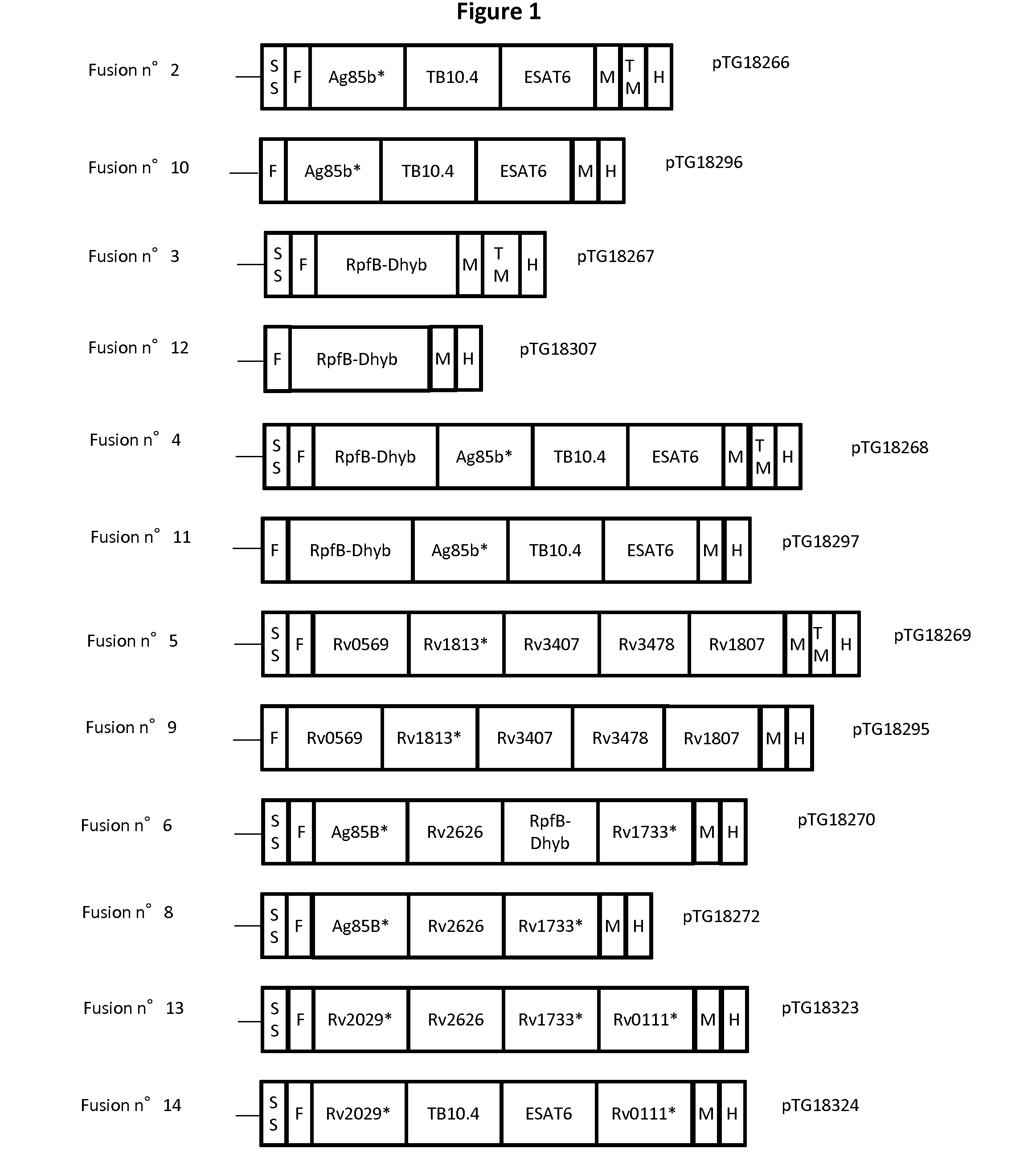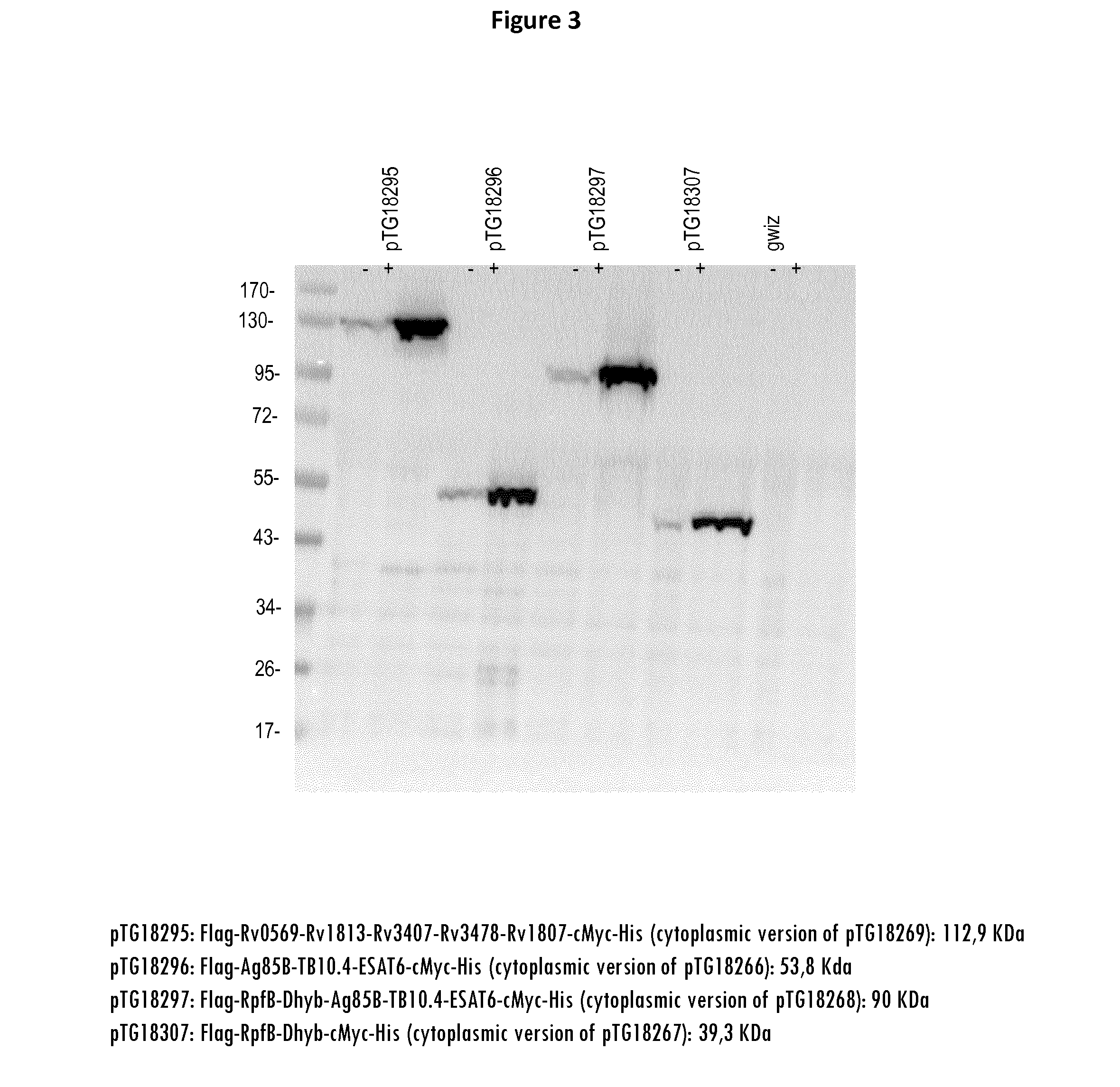Mycobacterial Antigen Vaccine
a technology of mycobacterial antigen and vaccine, which is applied in the field of mycobacterial antigen vaccine, can solve the problems of not being able to protect adults, not being able to operate alone, and not able to predict the pathogenesis of the majority of the mtb gene, so as to prevent mtb infection and/or primary tb, improve and unexpected immunogenic properties, and prevent reactivation
- Summary
- Abstract
- Description
- Claims
- Application Information
AI Technical Summary
Benefits of technology
Problems solved by technology
Method used
Image
Examples
example 1
Selection of Suitable Mtb Antigens for Immunogenic Combination
[0388]The Mtb genome expresses approximately 4000 genes but the function and role in Mtb life cycle of the great majority of the gene products have not yet been characterized. As described in Materials and Methods, existing data on Mtb antigens were investigated from the available literature and data bases with the goal of identifying the most appropriate set of genes / antigens from Mtb genome for providing an immunotherapeutic vaccine capable of raising anti-TB immunity during all phases of the natural course of infection.
[0389]These bibliographic analyses permit to “pre-select” a set of 33 Mtb antigens belonging to all three phases of infection, namely seven antigens of the active phase, five resuscitation (Rpf) antigens and 19 latent antigens as well as two PE / PPE antigens.[0390]Antigens of the active phase: ESAT-6 (Rv3875), CFP-10 (Rv3874), TB10.4 (Rv0288), Ag85A (Rv3804), Ag85B, (Rv1886) and two “ESAT-6 like antigens”...
example 2
Fusion Design
[0399]Extensive in silico structure prediction and bibliographical analyses were performed in order to predict biochemical properties and / or biological functions of the selected Mtb antigens as described in Materials and Methods.
[0400]The selected 14 antigen candidates were classified into three groups that required different types of analysis.[0401]Antigens with available data concerning their expression in various viral vectors namely Ag85B ESAT-6 and TB10-4 in MVA (Kolilab et al. 2010, Clin Vaccine Immunol 17: 793-801); vaccinia virus (Malin et al. 2000, Microbes Infect 2: 1677-85) and adenovirus (Mu et al., 2009, Mol Ther 17: 1093-100; Dietrich et al. 2005, J Immunol 174: 6332-9; and Havenga et al. 2006; J Gen Virol 87: 2135-43). In these cases, analysis of the bibliography was the main source of information to design the sequence to insert in vector constructions.[0402]Antigens with no data reported on viral vectorization but identical or homologous to a protein wi...
example 3
Construction of Mtb Gene Fusions
[0436]Twelve different fusion proteins were engineered as illustrated in FIG. 1 and Table 3. More specifically, 5 fusions were designed based on biochemical rationales as described below, respectively:[0437]Fusion n° 3 (RPFB-Dhyb*);[0438]Fusion n° 5 (Rv0569-Rv1813*-Rv3407-Rv3478-Rv1807);[0439]Fusion n° 6 (Ag85B*-Rv2626-RPFB-Dhyb*-Rv1733*);[0440]Fusion n° 8 (Ag85B*-Rv2626-Rv1733*); and[0441]Fusion n° 14 (Rv2029*-TB10.4-ESAT6-Rv0111*).
[0442]The following biochemical rationales have been followed to design the fusions[0443]Two dimeric proteins (i.e. Rv2626 and Rv2929*) should not be fused in the same fusion to avoid any steric clashes.[0444]Two membrane proteins should not be used in the same fusion (i.e. Rv1733* and Rv0111*) to avoid potential toxicity issue.[0445]Proteins with TM (Rv1733* and Rv0111*) should be inserted at the end of the fusion to allow plasmatic membrane anchorage for secreted constructions.[0446]If possible, the fusion protein should...
PUM
| Property | Measurement | Unit |
|---|---|---|
| temperature | aaaaa | aaaaa |
| temperature | aaaaa | aaaaa |
| time | aaaaa | aaaaa |
Abstract
Description
Claims
Application Information
 Login to View More
Login to View More - R&D
- Intellectual Property
- Life Sciences
- Materials
- Tech Scout
- Unparalleled Data Quality
- Higher Quality Content
- 60% Fewer Hallucinations
Browse by: Latest US Patents, China's latest patents, Technical Efficacy Thesaurus, Application Domain, Technology Topic, Popular Technical Reports.
© 2025 PatSnap. All rights reserved.Legal|Privacy policy|Modern Slavery Act Transparency Statement|Sitemap|About US| Contact US: help@patsnap.com



